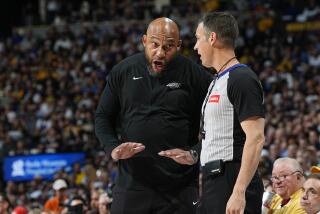ANALYSIS : Polls Produce a Split Decision : Penalty: Replays raise question whether clipping should have been called on Ismail’s 91-yard punt return.
- Share via
The play of the day--perhaps of the season--didn’t count.
In the last minute Tuesday night, as Raghib Ismail raced 91 yards to an apparent touchdown for Notre Dame, an official threw a penalty flag.
Clipping.
Clipping? That’s what the man said.
The call saved a 10-9 Orange Bowl victory for Colorado and set up a split verdict for No. 1 in the polls.
The writers and broadcasters voted for Colorado, the coaches for Georgia Tech.
But was it clipping?
If so, it wasn’t flagrant. It wasn’t even obvious. That much is clear from viewing the videotape of Ismail’s punt return, as furnished to The Times by Channel 4.
Although it will be in the books forever as clipping, it’s best described as last-second incidental contact.
And at that stage of a big game--at all levels in any sport from children’s leagues to the majors--the philosophy of the better referees, umpires and other officials is to make no call unless it’s more than incidental.
As the old referees say: “You don’t call foul (in the last minute) unless it jumps at you.”
And this one didn’t jump.
Thanks to instant replay and videocassette recording, this is what you see when you study Ismail’s run:
--As Ismail flies past the Notre Dame 30-yard line, Greg Davis, moves in to block a Colorado player, Tim James.
--Davis is coming from the side, not from the rear, and as Ismail angles to the right, Davis makes contact with James.
--At the instant of contact, the viewer gets a fleeting glimpse of a portion of the blocker’s gold helmet in front of James’ body. By definition, it’s clipping if the blocker’s head is behind the player’s body as he makes contact.
--The official is shown throwing the flag as he stands on the sideline at about the Notre Dame 43-yard line.
Ismail had come up the middle, then cut to his right to finish the run along the sideline. And as he flashes along, the official reaches for his flag and throws it.
It was either head linesman James Wilson or field judge Bobby Brooks--it is difficult to identify which--but he was perhaps 18 yards from Ismail when he saw the infraction.
Moreover, from his vantage point it would appear hard to tell exactly where the blocker’s head was positioned at contact.
Watching the tape, the hardest thing to tell is whether James could have made the tackle if Davis hadn’t been there.
James gets his hands on Ismail--he is one of five Colorado players who did--and he might have held on. It’s one of the many might-have-beens that will linger from the college football season.
More to Read
Go beyond the scoreboard
Get the latest on L.A.'s teams in the daily Sports Report newsletter.
You may occasionally receive promotional content from the Los Angeles Times.






